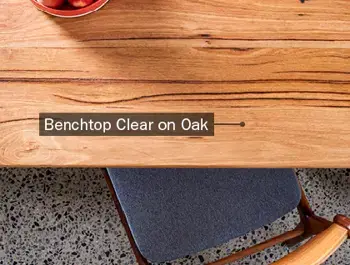Recoating Your Kitchen Wood Benchtops: The Power of Varnish
Wood is a classic look in any home. Warm, natural, goes with everything—it’s no wonder people want to protect or restore the natural timbers in their homes, especially areas like kitchen benchtops that are exposed to heat from hot mugs and cups.
Do you have a wooden benchtop in your home that's in need of some care? Cabot's Benchtop Clear Water Based can rejuvenate kitchen and living area benchtops, making them resilient to heat, chemicals, and stains, all while providing a revitalised appearance. This product is perfect for various wooden surfaces, including solid timber, bamboo, plywood and engineered timber. It's not only food-safe but also effectively guards against unsightly heat marks caused by hot cups and plates.
Here’s what you’ll discover:
Why use varnish on kitchen timber benchtops?
Using varnish on kitchen timber benchtops offers several compelling advantages, making it a popular choice for homeowners. Here are the key reasons why varnishing kitchen timber benchtops is a practical and beneficial decision:
- Easy Cleaning: Varnished benchtops are smooth and easy to clean. The sealed surface allows for effortless wiping down with a damp cloth or mild cleaning solution, saving you time and effort in maintaining a hygienic kitchen.
- Ease of Application: Varnishing a timber benchtop can be a manageable DIY project with the right tools and instructions. It can provide a professional-looking finish when done correctly.
- Aesthetic Enhancement: Varnish enhances the natural beauty of the timber by accentuating its grain, color, and texture. It can be applied in various finishes, from glossy to satin, allowing you to customize the look of your benchtop to match your kitchen's style. The clear satin finish enhances the natural beauty of the timber and is ideal for use on kitchen benchtops.

Cabot's Benchtop Clear is a premium-grade, heat-resistant varnish for wood that's perfect for living areas and kitchen timber benchtops. On top of providing heat resistance, it's also:
- Stain resistant
- Fast-drying
- Low-odour
- Non-yellowing
Cabot's Benchtop Clear varnish forms a layer over the top of the wood, protecting it from spills and everyday wear and tear.
But bear in mind, as all woods are relatively soft compared with materials like stone, it won’t keep your surfaces completely scratch-free. When you see the varnish wearing or want to remove scratches, sand back the wood and a new coat. Keep scrolling for detailed instructions on how to do this.

Shop Cabot's Benchtop Clear at your nearest hardware or DIY store.
How to use benchtop coating varnish: easy step-by-step guide to prep and application
What you’ll need

240-Grit Sandpaper
Preparation
To prepare all wood for varnish:
- Remove scratches and worn marks by sanding back to bare wood
- Remove any polish with a polish remover, and
- Use mineral turpentine to clean the surface from stains, dirt, wax, grease and oil.
Bare Interior Timber
- Sand the surface smooth using 180 –240 grit sandpaper. Sand only in the direction of the grain.
- Remove all traces of sanding dust.
Previously Coated Interior Timber
- Thoroughly clean the wood surface with Cabot's Floor Clean and allow to dry.
- Apply one coat of varnish to a small test area. Allow to dry for 24 hours. Press sticky tape firmly to the surface and pull off quickly. If the coating comes off, sand back further to a sound surface.
Application
Important! Do not shake the can.
- Stir varnish thoroughly with a broad flat paddle before and during use.
- Apply first coat of varnish with a good quality brush , short nap roller (between 4 -8mm long), or spray gun. If spraying, back brushing is recommended. If brushing or rolling, always apply in the direction of the grain.
- Allow to dry for a minimum of 2 hours.
- After applying the first coat, fill nail holes, cracks and other defects with Cabot's Wood Tone Putty. Then, lightly sand to remove any grain raise using 240 grit paper. Remove all sanding dust.
- Apply second and third coats using the same method. You don’t need to sand in between these coats.
Featured: Transform Your Wooden Interiors: How To Use Wood Varnish Like a Pro
Wrap-up: Key points
- Cabot's Benchtop Clear is a premium-grade, varnish for wood that is perfect for living areas and kitchen timber benchtops as it's: stain resistant, fast-drying, low odour, and non-yellowing.
- Wooden surfaces should be prepared by removing scratches and worn marks, any polish with a polish remover, and any stains, dirt, wax, grease or oil with mineral turpentine.
- Applying Cabot's Benchtop Clear involves stirring the varnish thoroughly before use and applying the first coat with a brush or roller in the direction of the grain. Allow to dry for 2 hours before applying the second and third coats without sanding in between them.
Got a question we haven’t answered? Call 0800 222 687 for free advice from a Cabot’s expert.


